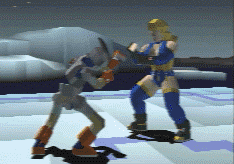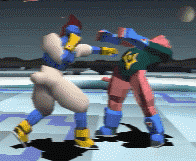Tobal No.1 is amazing!
What is almost as amazing (or strange, take your pick) as the game’s name is the fact that one of the best 3-D home fighting games for any system is made by Square, of Final Fantasy fame (though, sadly, for this reason, Tobal will probably end up as another classic sleeper, as are most of Square’s games anyway). If there is any comparison to Tekken 2 in terms of gameplay, (don’t get me wrong, there certainly is because the styles are so different) then the innovation, depth, and replay value pushes Tobal No.1 a couple notches above where any fighing game has gone before.
First the fighing game basics: Tobal No.1 has 8 fighters (what seems to be the magic number for first-time fighting games), 3 bosses, as well as a slew of hidden characters, a very helpful practice option, as well as the first true three-dimensional interface ever in a fighting game.
The graphics are beautiful, complete with backgrounds filled with vivid, colorful landscapes, that will actually cause you to lose a fight or two, because you need to battle not only with your opponent, but with your concentration as well. You fight on raised platforms that are actaully a bit small, and could have used small little effects to shadow these shortcomings, like maybe some more interactive backgrounds, or backgrounds with different levels. But with Square having this much to work with, these things might be all they have left to tweak once Tobal No.2 rolls around.
The characters lack the texture mepped qualities of Tekken 2, and the polygons look much more like polygons rather than real people (and creatures). The makes the game look much less impressive at first glance. But the fighters make up for this with their amazingly smooth motion. The frame refresh rate is astonishing!
The fighting moves, are colorful, with very fluid, precise movements that range from neck-wrenching DDT’s to breakdancing sweeps. Even the fighter’s individual victory celebrations are enjoyable, as you will undoubtedly find yourself picking a character to see his or her hilarious victory jig (I can just see Hom being given a pair of authentic Adidas dancing pants and a bicycle helmet to see him really get down). The sound is also very absorbing, especially the crisp sound effects that also help determine the timing for when you’re open for a combo, or a return blow.
The control is what really helps make this game such a hit. Square not only met the existing standards for control that previous fighting games had set (a feat in itself) it threw a new twist, and still made it work. Tobal No.1 is diffferent from all other 3-D fighting engines, but at the same time just as good, even arguably better.
They did this by including what seems almost blasphemous in terms of fighting game standards: they made a true jump button. Before clicking to another article, let me explain. The jumping in this game is very realistic, and the fighters can only jump a couple of feet high, as in real life. Although the jumping button takes a while to get used to, and most moves involving jumps are choppy at best, it opens a whole new variety of depth in terms of combinations, and when used as an escape route, can cause match-turning momentum swings. Also, it is rarely used in a really heated battle, because face it, whether it’s an Eddie Murphy street fight, or Karate Kid VII, how often do you see 10 foot backflips determine the outcome of a battle?
This innovative new move by Square enhances the first true 3-D interface of any of the ‘new age’ fighters. If you remember Toshinden, or especially Tekken, you’d know that you basically could control your fighter in only 2-D dimensions, like Street Fighter. Tekken was even worse without the ‘rolling’ button that Toshinden has (although the catch was, it made the game a bit too easy). Although the moving camera angles of each game worked fine, Tobal made an substantial improvement in allowing you to use the up/down directions for moving around in any direction, a change that feels suprisingly natural.
The ability to move from almost infinite angles opens a world of new situations and options to choose from. Now, you have to plan different defenses and strategies for when facing someone from the front, the side, or from behind, and there are a variety of attacks to use from each angle, especially when throwing someone. Grabbing someone is just the beginning of throwing someone; after that you can knee/headbutt/punch them, release them, move them to any point you desire, throw them away from you so that their back is to you (to then do with them as you will), oh, and of course, throw them. But, doing all this does not come easy, as your opponent can attempt to throw a grapple lock on you, break the hold, strike back at you, even do a counter throw in the middle of being thrown, which is sweet, if you can get it off.
The attacks are a little Virtua Fighter-esque, with a lot of chain attacks that largely depend your timing. There are no high/low punch or kick buttons, just high, low and medium attacks that are dependant on the fighter. Not much is too revolutionary here, expect for the tweaking of the little things, like being able to get up from knockdowns with out any frustrating delays. Long-stringing hit combos, past maybe 3 hits is pretty difficult, though you will have plenty of chance to work on them in the very convenient practice mode.

The characters are a trip… Mary Ivonskaya is listed as an ‘elegant’ 6’2″ and 308 lbs, and The Mysterious Nork an eye-popping 9’9″ and 771 lbs! Illgoga looks like Goro’s cousin minus two limbs, and Oliems looks like the Foster Farms Super Chicken. There is a variety of everything in these fighters, and alot of the special attacks are throws. It is very easy to get accustomed to a fighter’s style, although speed is an unfair advantage on this game if you know how to use it. Chuji, (who is the game’s poster boy, it seems) is the easiest to use and is arguably better than all the other fighters. They all have the usual interconnecting storylines that are later explored to a greater extent in. . . the Quest Mode.
Although a VS. mode is often used in action/adventure type games, the converse is never true for fighting games, making Tobal’s quest mode (what a surprise from Square: quests. . .) by far the best and most innovative feature since–well, bosses. The quest mode adds a whole new level of richness and depth to the game and with intertwining storylines and additional chararcters. This gives you the drive to complete it with all the characters, not just one.
The quest levels are simple dungeon type levels with varied maps and floors. These are very challenging, rich with power-ups and potions, and a helpful little map, although still it is sometimes difficult to keep a sense of direction on the more challenging levels. You have to use a world of different techniques in the quest mode, and that precise control I told you about before gives you control of almost any camera angle you need, as well as the ability to move in any direction you need. Now if Capcom, Acclaim, or SNK were able wake up and smell the transistors. . .
This game has a few minor shortcomings, but as the title implies, this is Tobal No.1, so you can imagine what Square might have planned in the future. For one thing, blocking is too hard to get used to, and at many times in the heat of the battle, you may have to abandon it completely, or only use it for ducking. There are too many combinations to learn for blocking, such as a low block for a high punch, or a high block for a high kick, so although it is not impossible, it is confusing.
Another annoying feature is that although the jumping being realistic is cool, the jumping attacks, though rare, are very choppy and are moves you usually think about rounds in advance (also, jumping punches to offset the kicks would’ve been a nice touch). The fighting platforms are kind of small, so in 2-player matches especially, it is easy to grab someone and shove them right off the mat, although Square definitely compensated for this with precise control. You can almost tiptoe yourself along the side of the platforms if you are that close to the edge. Speed, as I stated before, can be an unfair advantage with characters such as Chuji and Gren, once you master the moves and the timing, although there are a wealth of moves to learn that will you have to figure out on your own. This is also good, because although the computer is kind of easy to beat, it has a pretty smart AI (I know that sounds backwards) because it doesn’t fall for the same trick twice. The attacks are really what determine the outcome of the battle, because some 3 hit combos can take almost 30 or more percent of your energy.
Despite being a little rough around the edges, especially compared to Tekken 2, this is a great addition, maybe the best, to the resurgent fighting genre. And with the beautiful Final Fantasy VII sampler pack included, this is one of my top choices for the holiday season. If pure unadultered fighting is your thing, I’d put this this one second to Tekken 2, but if you want a deeper, more complete game then Tobal No.1‘s your man, err…, monster, game, or whatever.
-
- Very Innovative
-
- Quest Mode
-
- Truest 3-D Interface on the Market
-
- Very vivid graphics, though a tad blocky











